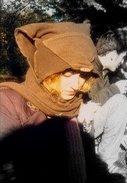For
Bausch, choreography reaches into the elastic arenas of time and space, her vision is a coordination and organisation of memory, music, costume, lighting, set and movement; a dance between multiple elements to create a tanztheatre of a human condition, a social and personal observation of intimate exploration. There is an emotional yearning and impetus that drives the evolution of her work, and these are essential ingredients in her choreographic overview.
“When I first began choreography, I never thought of it as choreography, but as expressing feelings . . . In the work everything belongs to everything else – the music, the set, the movement and whatever is said. I don’t know where one thing stops and another begins”
As dance theatre Pina Bausch’s is a synaesthesia, one that allows us to see, hear and smell in equal degrees. It is rooted in the senses; she is an artist of water who flows into a seamless tapestry of experience, deriving her inspiration from the oceanic depths of human experience contextualised through both society’s and nature’s reflections.
Bausch emerged from expressionism, taking up the trails left by
Mary Wigman, and
Rudolf Laban. Laban’s profound interest in the affects on movement of psychological and emotional states was a direction shared in other areas of performative studies; the
Strasberg school of acting was also seeking subtle gestures of integrity, a movement away from the grand emotions and mythical themes of more traditional forms of theatre, and most relevantly those expressed in classical ballet. Bausch did have a personal background in dramatic dance technique, (the psychological style of her tutor at Julliard School, Anthony Tubor, built upon emotive gestures), but it was Kurt Joos who became her mentor, with his emphasis on the individual’s role in society as impetus for movement patterns, and on individual expression. No doubt his politicisation of dance inspired Bausch’s own direction towards socio-political observations within her own work.
Bausch’s work is psychological in a sense, it is a narrative of that which moves the body (rather than what the body moves), but a narrative whose telling is experienced through the sum of its parts, rather than a logical linear sequence of events; she exhumes the struggles and tensions within, to undermine fear’s power of oppression in the open airing of performance and draw the simple beauties of life and its minutiae into the light. She may reject the label or box of meaning, so long as there is a meaning to be found within the mind of the spectator, a resonance. It is in a sense to heal. Therefore her choreography is a process of delving into memory and emotion – her aim is to create a holistic organic work through the exploration of fragmentation.
Her background is important in understanding her choreographic principles. Her work is in no small way a rebellion against the superficiality and deception she found in classical ballet. She criticised its training rituals, how it alienates the body from its own impulses. She broadened the concept of dance, releasing the term ‘choreography’ from its narrower definition as a series of connected movements. “To understand what I am saying,” Bausch says, “you have to believe that dance is something other than technique. We forget where the movements came from. They are born from life. When you create a new work, the point of departure must be contemporary life – not existing forms of dance.”
The dancers themselves are imperative to the development of Pina Bausch’s performances. As with
William Forsythe, Bausch has a core of dancers that she works with over a period of time. These dancers “provide the material, the building blocks, from which Bausch must then select and edit, reconstruct and build. They are the consciousness of the piece rather than merely ciphers for the explorations of Bausch as auteur”. The process of creation is highly collaborative, where all contribute their own experience toward the metaphoric construction of the whole. These building blocks are carved from the raw materials of the emotional lives and memories of the dancers, investigated throughout the rehearsal process.
Here, Pina poses questions to be explored, little images to stimulate the dancers’ creativity, such as imagining ‘a symbol for freedom’; ‘a song to a tree’; ‘playing games to subdue fear’; ‘setting a trap for someone’; or alternatively she may ask “When you cry, how do you cry? What do you do when you cry? Many different ways of crying. What do you feel, what sounds do you make?” From here may arise a dancing with fingers, the isolation of memories, all of which are tools of choreography to be translated into picture and sound. Through the noting down of what they feel, and the answers to these questions, sequences of steps are born, to be tested and filtered, thrown out, repeated, reordered, repeated, until natural movement is transposed into that of dance. These improvisations are worked through and condensed until their integrity resonates in aesthetic form.
Maria Shevtsova describes part of this process in her term movement trouvé, where an accidental movement or stimulus might be seized upon and developed into a workable motif. Pina Bausch holding her baby in the rehearsal room inspires a copycat exercise that reveals a poignant physical dialogue between two adults; or the exercise of taking a sentence and playing, acting with gestures to express what had been written down – not with the face but with gesture, expression through the body.
Thought is creativity, Bausch affirms, working and thinking about things. With curiosity comes problems, yet it is integral to creativity, and understanding people, life. It is essential to ask ‘Why do we dance?’ Movement is derived from experience itself… ...






